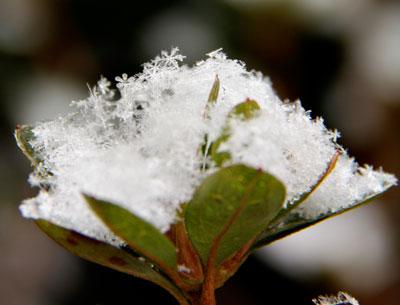Nature Notes: Quintillion Water Molecules

As I write this column it is blowin’ and snowin’ up a storm. The weather reports on all of the media say we are in for a big one. The various reports remind us of the “Blizzard of ’88” (that’s 1888 for you millennial readers) and the famous storm of 2006, which dropped 26.9 inches in Central Park.
The biggest Long Island snowstorm that I can remember was the one that occurred in 1947, two days after Christmas. My family was visiting my Aunt Esther and Uncle Jake’s family in West Hills for the holidays. Well, it snowed and snowed and snowed, and when it was done snowing it was more than two feet deep.
My brother, Bobby, then 20 years, had to get back to Mattituck for some event, so he and I hitchhiked back along the Jericho Turnpike, which was a few hundred yards down the hill to the north from where we were staying. There was no Long Island Expressway at that time, and Route 25 was the main thoroughfare to Riverhead, where the two forks separated. The road was mostly cleared, and in less than 15 minutes we thumbed a ride and were on our way east. In those days there were very few weirdos on the road, no busses, and hitchhiking was the best means of transportation for long distances outside of the family automobile.
Snow is frozen rain that starts with a particle of dust, pollen, clay, or some other tiny thing that serves as a nucleus for the collection and freezing of water droplets when the temperature in the upper atmosphere is below zero. As many as a quintillion water molecules can go into the creation of one snowflake, and the snowflake can get as big as a few inches in diameter or more, but most rarely exceed a half inch across by the time they reach the ground.
Everything one can think of is studied by scientists these days, and snow is no exception. In 1951 an International Commission on Snow and Ice created a classification of snowflakes. That classification was much improved by a Japanese physicist, Ukichiro Nakaya, who in 1954 categorized snowflakes into 42 different types. In 1986 Nogono and Lee improved upon Nakaya’s taxonomy and came up with 80 different types. A Cal Tech scientist, Ken Libbrecht, came along and photographed hundreds of snowflakes and wrote four books about his work; one, “A Field Guide to Snowflakes,” was a best seller. (No one has published “A Field Guide to Raindrops,” but I’m sure one is in the offing, even though raindrops aren’t white to the human eye and have a very limited number of shapes.)
Looking at snowflakes under a magnifying glass or microscope is dangerus. They are so damn beautiful one could spend the rest of his or her life in that kind of self-indulgence, especially in a world that abounds in ugliness as never before. It is said that no two snowflakes are alike, but that idea has been debunked by a scientist with the National Weather Service, who, after examining thousands, found two that were identical hollow-tubes forms.
More than 90 percent of snowflakes are hexahedrally round. The six-sided form has to do with the way hydrogen and oxygen bond when water molecules bond to each other in subzero temperatures around the snowflake crystal’s nucleus. Sometimes the snowflake’s tetrahedron form when viewed head-on looks like a standard two-dimensional hexagon. Most of the time there are “spiny” structures, also very symmetrically composed, radiating out to form a six-rayed star.
Occasionally, snowflakes will ball up under a mucilage of goop, in which case they are known as “graupel.” Linguists have for a long time argued over the assertion that Inuits and other Arctic-Circle peoples have hundreds of different words for snow, while we in English have fewer than six. Much of the support for such a finding comes from the work of Franz Boaz while studying the Baffin Islanders. A woman who recently studied Inuit languages came to the conclusion that the Inuits really have only six different words for snow, not much different than the English lexicon. The jury is out on the matter for the time being, but a fairly recent study of the Sami language of Norway’s aborigines came up with 180 different words for snow and 500 for reindeer.
I would like to stay up and see if the storm raging outside will qualify as a blizzard, but I have to get this in before bedtime or else it won’t make it into print. My bet on Monday night, however, is that for us here on the South Fork it will be just another northeaster and that the snow accumulation will be under six inches, hardly enough to qualify for blizzard status. I should warn the reader that 9 times out of 10 my predictions come out dead wrong.
Here’s another that has to do with winter weather: Deflated footballs will not help New England win the Superbowl; they’ll be playing in Arizona and the temperature will be close to 65 degrees.
